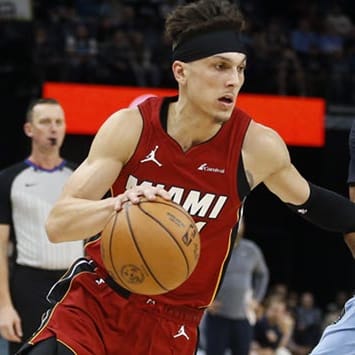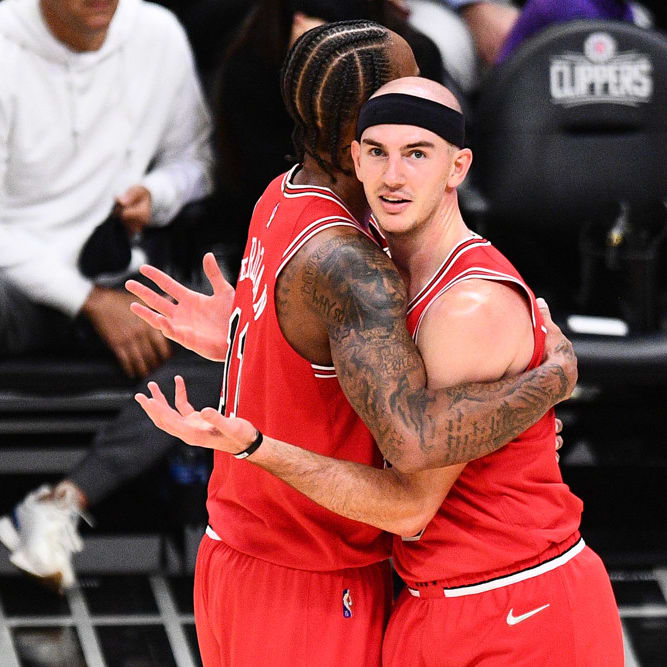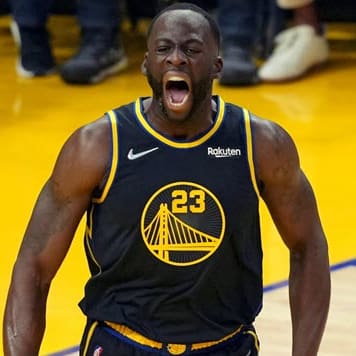This article is part of our NBA Draft Kit series.
While mining the deep end of the player list for sleepers might be the most fun part of draft preparation, working to avoid potential busts is equally important, especially in the early rounds.
This season, there are plenty of talented players who should be approached with caution due to their injury history, but what about players in new or unsteady situations?
The list of true "busts" in fantasy basketball is relatively short. Unlike in the NFL, it's quite rare for an elite NBA player's production to go through drastic, year-to-year swings. For the most part, you can expect the best players to play well -- or at least finish within a reasonable distance of their preseason projection.
Of course, each year a few players make the leap into the elite tier, but -- barring an injury -- it rarely happens the other way. A player in his relative prime going from, say, the 10th-ranked player one year to the 60th-ranked player the next is almost unheard-of.
With that in mind, the following players are less on bust watch than they are on likely to be overdrafted watch. Let's dig in:
Marc Gasol, Grizzlies
It's difficult to gauge how much stock we should put into Gasol's 2017-18 numbers. It was an injury-riddled season for Memphis, which claimed its lowest win total (22) since Gasol joined the team. Without Mike Conley, the Grizzlies leaned on Gasol even more than usual, and he responded by posting the lowest field-goal percentage (42.0%) and highest turnover rate (2.7%) of his career.
Though Gasol's longevity is impressive, the list of highly productive centers during their age-34 season is a brief one. Averaging Gasol's first All-Star season (2011-12) through his latest (2016-17) spits out 16.2 points, 7.5 rebounds, 3.8 assists and 1.5 blocks per game. Subtracting the assists from the equation, those numbers have only been achieved by four centers at or above 34 years old in the three-point era: Kareem Abdul-Jabbar, Artis Gilmore, Hakeem Olajuwon, and David Robinson.
If Gasol was essentially on his own again, I'd feel better about him joining that list of Hall-of-Famers. However, the offense should be a bit more egalitarian this season, as Conley will begin the season healthy and depth was added on the wing. Perhaps most importantly, the organization used its fourth overall pick on Jaren Jackson Jr., the reigning Big Ten Defensive Player of the Year and eventual heir-apparent to Gasol. While Jackson is a strong candidate to start at power forward, he'll also be used at center to take some of the workload off Gasol, who hasn't slipped below 30 minutes per game in his decade-long career.
DeMar DeRozan and LaMarcus Aldridge, Spurs
Kawhi Leonard played all but nine games last season, leading to LaMarcus Aldridge stepping up as San Antonio's No. 1 option. He ended up averaging his most field goal attempts (18.0) and points per game (23.1) since leaving Portland. In Leonard's place this season will be DeMar DeRozan, who was the No. 1 option in Toronto, averaging 23.0 points on 17.7 shots per game. As teammates, each will have to sacrifice some offensive responsibilities.
During Aldridge and Leonard's first year together, Aldridge took 14.1 shots per game, while Leonard attempted 15.1. In Year 2, Aldridge took 14.6 shots and Leonard took 17.7 shots as he firmly established himself as the No. 1 option and one of the 10 best players in the league. The Aldridge and DeRozan pairing projects to play out more like the first year of Aldridge/Leonard -- a 1A and 1B scenario. However, it's unclear who will ultimately make more of a sacrifice.
DeRozan isn't the complete player Leonard was during the first two years of Aldridge's tenure in San Antonio, but he makes for a pretty strong substitute in terms of usage. With that in mind, Aldridge sinking back toward 14 or 15 field goal attempts per game feels like a safe bet.
DeRozan, himself, hasn't taken fewer than 15 shots per game since he was 23, and obviously he's made significant strides since then. Looking at the 29 games last season in which he attempted 13-to-17 shots (15.6 FGA/G), DeRozan averaged 18.7 points, 5.5 assists, 3.9 rebounds and 1.1 steals. Taking into account what could be a reluctant adjustment to a new system and new teammates, that's the kind of production DeRozan could be looking at this season.
Lou Williams, Clippers
A myriad of injuries, particularly to Patrick Beverley and Milos Teodosic, essentially forced Doc Rivers to give Williams the most minutes of his career during his age-31 season. The veteran set a number of career-highs, averaging 22.6 points, 5.3 rebounds and 2.4 threes while shooting 43.5 percent from the field. Management rewarded his efforts by giving him a three-year, $24 million extension in early February.
Both Beverley and Teodosic are expected back healthy at the beginning of this season and the Clippers still have Avery Bradley, who was acquired as part of the Blake Griffin trade then lost to injury shortly after. Plus, the Clippers acquired a pair of guards -- Shai Gilgeous-Alexander and Jerome Robinson -- with their two lottery picks, creating a backcourt logjam that was only modestly eased by the trade of Austin Rivers to Washington.
Given the added depth and decent chance of a mini-rebuild, Williams appears to be trending more toward his usual sixth-man role, which is what we saw from him while Beverley played the first 11 games of last year. During that sample, Williams averaged 16.6 points, 3.3 assists and 2.0 threes on 46.7 percent shooting across 24.6 minutes per game. Williams likely won't be any less of a player this season, but it's hard to imagine the same minutes load being there.
Kentavious Caldwell-Pope, Lakers
Playing on a one-year, $17.7 million contract last season, Caldwell-Pope joined the Lakers after spending his first four seasons in Detroit. In 33.2 minutes per game, he set career highs in field-goal percentage (42.6), three-point percentage (38.3), made threes (2.1) and rebounds (5.2). He also remained a quality source of steals, matching his career-high with 1.4 per game.
Caldwell-Pope wasn't alone in his success on the wing. Josh Hart, the 30th overall pick in 2017, arguably outplayed Caldwell-Pope through the final 18 games of the season. In those games, the rookie averaged 14.1 points, 7.2 rebounds, 2.2 threes and 1.0 steal while shooting 50.6 percent from the field and 44.0 percent from deep. Hart is clearly part of the Lakers' future, while Caldwell-Pope settled for a one-year deal for the second straight summer to remain in LA.
Joining LeBron James in Los Angeles are the likes of Lance Stephenson and Michael Beasley. Neither player is a starter, but both will have roles for what's developed into a deep but very much flawed roster. We still don't know how, exactly, Luke Walton's rotation will work out, but Brandon Ingram and Kyle Kuzma are unlikely to see significant dips in workload, either. All things considered, Caldwell-Pope could be the odd man out, at times, and he's at risk of seeing his fewest minutes since his rookie year.
Josh Jackson, Suns
Jackson was selected with the fourth overall pick in the 2017 Draft after turning in a First Team All-Big Ten freshman season at Kansas. Prior to the All-Star break, he was averaging just over 23 minutes per night, but as the Suns shifted into tank mode after the break, Jackson's minutes rose to more than 30 minutes per game, and he responded by averaging 18.7 points, 5.9 rebounds, 2.5 assists and 2.1 combined steals/blocks.
Jackson's counting stats made him a valuable fantasy player in points formats, but the same couldn't be said for eight or nine-cat leagues. Despite his increased production after the break, Jackson still shot a subpar 43.8 percent from the field, 68.2 percent from the free-throw line, and had 49 turnovers, compared to 50 assists.
Still only 21 years old, Jackson should continue improving. However, his competition for playing time has increased rather dramatically. The Suns acquired swingman Mikal Bridges from the Sixers on draft night, somewhat of a curious move after selecting a similar player in Jackson the previous year. Compared to Jackson, Bridges projects as a better shooter without much sacrifice on the defensive end. During his senior year at Villanova, Bridges made 2.6 threes per game on 43.5 percent shooting and was named the Big East Defensive Player of the Year.
In addition to Bridges, the Suns still have Devin Booker and T.J. Warren, and they paid up to add Trevor Ariza in free agency. Even if we assume the Suns are still committed to Jackson long-term, his path to playing time in the immediate future -- one in which Phoenix apparently sees itself as a playoff contender -- isn't as clear as it once was.
Trae Young, Hawks
One of the most divisive top picks in recent memory, Young will start at point guard next season for the Hawks following an explosive freshman campaign at Oklahoma. Posting a 37.2% usage rate -- which would have led the NBA last season -- Young averaged 27.4 points (including four 40-point outbursts), 8.7 assists and 1.7 steals. He also launched 10.3 threes per game, hitting them at a 36.0 percent cilp.
Despite Young's strong overall production, critics will point to the fact that he fell off a cliff near the start of Big 12 play. Young shot 39.9 percent from the field and 32.6 percent from three in conference, and he committed 6.1 turnovers per game, compared to 8.1 assists. Beyond the numbers, Young's slight frame and average-at-best athleticism predict that he could struggle to score against bigger, stronger NBA defenders. Many of those worries were realized during summer league, where Young struggled. Across seven games in Utah and Las Vegas, Young played the same freewheeling style that we saw at Oklahoma but shot just 30.3 percent from the field, 27.3 percent from deep and committed 26 turnovers to 40 assists.
It seems all but guaranteed that Young will see a high usage rate as a rookie considering management's confidence in him and the Hawks' place as a doormat in the East. Fantasy-wise, points leagues should favor the rookie, but the very realistic possibility of a low field-goal percentage (on high volume) and high turnover rate could tank his stock in categorical formats.
Dewayne Dedmon, Hawks
At age 28, Dedmon saw the most run of his career last season with the Hawks -- his third team in as many years. He started 46 of his 62 appearances, averaging 10.0 points and 7.9 boards in 24.9 minutes. Dedmon also added the three-ball to his game, going 50-of-141 (35.5 percent) from beyond the arc after attempting just one three prior to 2017-18.
With the Hawks deep in a rebuild with a new coach in Lloyd Pierce, it's unclear how big of a role Dedmon will occupy this season. Sophomore big man John Collins, who played nearly 40 percent of his 24.1 minutes per game at center last season, will be prioritized. Alex Len and Miles Plumlee are also in the mix at center and combined for 36.9 minutes per night last season in Phoenix and Atlanta, respectively.
It's certainly possible that Dedmon sees a similar workload to last season, but his fantasy upside is rather low, and the direction of the team suggests the playing time will eventually be divided up among younger players. While Dedmon has proven to be a productive fantasy commodity when the minutes are there, he's simply not worth the gamble before the later rounds of most standard drafts.












